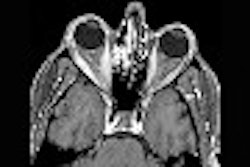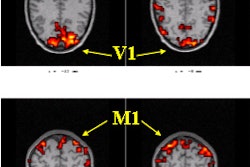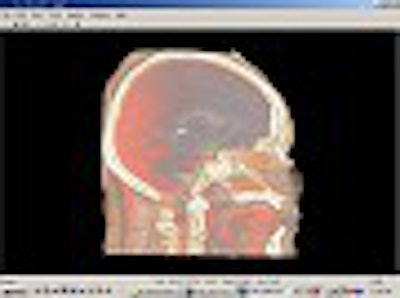
At times, even the latest imaging technologies can be frustrating. What practitioner hasn't longed to carve away the fuzz from a 3-D ultrasound picture with the flick of a finger, shift the subject for a better view -- or even touch target areas for a better look at what's on the screen? But doing so would require exploratory surgery.
Until now, that is. Novint Technologies has developed new software called e-Touch that allows users to interact with images -- such as ultrasound, MRI, and CT scans -- as if they were reaching inside the picture to explore and clarify what they see. Novint is a subsidiary of technology developer Manhattan Scientifics of New York City.
According to Novint founder Tom Anderson, e-Touch is based on data from an imaging exam that is performed as usual. Once the scan is complete, the user pushes a button that transfers the data into e-Touch. Grasping a stylus attached to a robotic device called Phantom (SensAble Technologies), users can manipulate the image in 3-D.
How? Phantom’s stylus controls a cursor on the computer screen. As the user moves the stylus through the air, the cursor correspondingly moves across the 3-D image. When the cursor touches an object in the image, e-Touch registers the contact by coordinating the image’s data with Phantom’s motors.
For example, a solid, dense object triggers Phantom’s motors to significantly decrease the stylus’ forward movement. The user may register a slight sense of "squishiness," as though the stylus were touching human skin. As the user moves the stylus -- and therefore the cursor -- across the object, he or she will feel the object’s contours and texture.
Anderson has used e-Touch with 3-D ultrasound to "feel" his unborn baby.
"Once the data is in our system, you can see the baby’s face," Anderson said. "You can rotate it so you can see it from any direction, and then, while you’re holding on to the stylus, you can feel all the way across the baby’s face. It was a real amazing experience for me, as a dad."
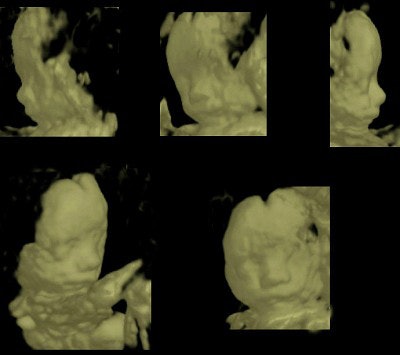 |
| Views of Anderson's son obtained using e-Touch software. Images courtesy of Novint Technologies. |
The feel-good aspect alone makes e-Touch worthwhile for some, but the software has many practical applications as well, according to the company.
"Our software allows you a much stronger and more intuitive interface to the data," Anderson said. "In the case of 3-D ultrasounds, you could go in and take measurements more accurately, because you can reach in and actually touch specific places. You can go through (with the stylus) and you can clean out the data set. You can also set a clip plane that cuts through the center of the vertebrae, for example, so you get a cross-section of the vertebrae really quickly."
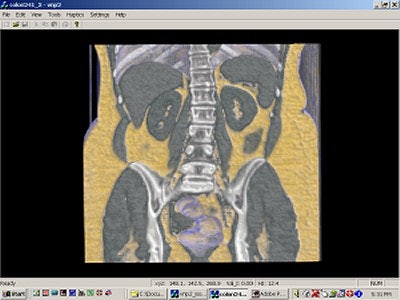 |
|
In CT adominal scans above and below, the cursor is controlling a real-time clipping plane, which can be positioned with a full 6º of freedom. 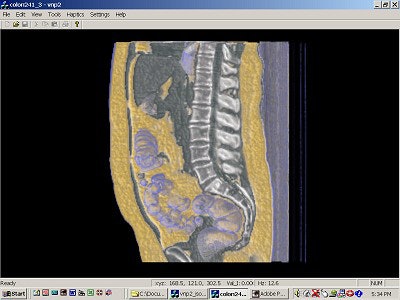 |
Anderson founded Novint Technologies in April 1999, after obtaining an exclusive license to the software from his former employer, Sandia National Laboratories of the U.S. Department of Energy. In May 2001, Novint Technologies merged with Teneo Computing, which had a product called VoxelNotePad. Acquiring Teneo’s software enabled Novint’s e-Touch to analyze and segment volumetric data sets, like the ones produced by medical imaging modalities.
To refine the product, Novint is working with Janis Carrasco, a sonographer and the co-owner of New Mexico Sonographics in Albuquerque, and Dr. Glen Haywood, an assistant professor of surgery and surgical oncology at the University of New Mexico, also in Albuquerque.
Carrasco’s facility provided the 3-D ultrasound data that Anderson has used to test e-Touch. Carrasco believes the technology will help practitioners diagnose any number of diseases and conditions. In her case, Carrasco believes e-Touch will help her better examine babies before birth.
Haywood is working with Novint to streamline the data-transfer process and to ensure that the data transferred is accurate. As a surgical oncologist specializing in gastrointestinal surgical oncology, Haywood said the importance of radiology to his preoperative planning is paramount. He believes the image enhancement added by e-Touch will prove revolutionary for healthcare.
"By the time (patients) end up seeing me, they would have had multiple studies: CT scan, MRI, ultrasound. We hang these on a viewbox and say, ‘Oh yeah, the tumor may be located here and there.’ But we use 2-D studies to make the decision," Haywood said. "Now we can manipulate the data and get maybe a more accurate assessment of the tumor’s proximity to these major structures. That may help us to increase our accuracy at the time of operation. Also, the technology helps us with simulation. We can potentially practice the surgery before we get into that patient’s abdomen."
Like Anderson and Carrasco, Haywood feels that interacting with images will improve diagnostics. "While major imaging modalities have really come a long way, these modalities lack the ability of touch," Haywood said. "You can see it on the screen, but you cannot feel the texture of the liver, you cannot pull on the gallbladder and feel the gallbladder tension on that blood vessel. (Touch) is absolutely important."
Anderson believes the software will cost approximately $40,000 when it becomes commercially available in mid-August, and the company plans to sell it directly to physicians for use with all types of imaging modalities. The application currently works with the Voluson 730 3-D ultrasound scanner from GE Medical Systems of Waukesha, WI. But Anderson said that Novint could add support for any other 3-D scanner.
At first, Novint plans to sell the software on its feel-good qualities, marketing it to practitioners with 3-D ultrasound machines to enhance a patient’s pregnancy experience. Carrasco and Haywood said that the cost was well worth e-Touch’s advantages; both intend to purchase the software once Novint makes it commercially available.
"I think this is just the beginning," Carrasco said. "It amazed me from just the little bit that I got to play with it. It’ll be interesting to see the different ways that it can help the medical field."
By Leslie FarnsworthAuntMinnie.com contributing writer
July 17, 2002
Copyright © 2002 AuntMinnie.com





